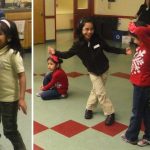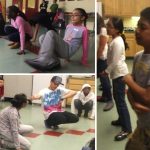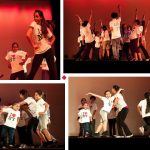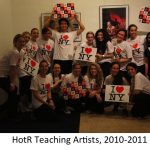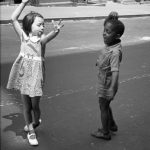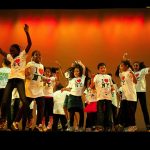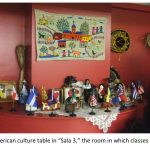Danthropology: A New Interdisciplinary After-School Project in Structured Play – by Kelly Vaghenas
Posted in: Director's Essay
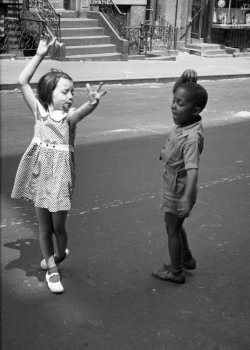
[Editor’s Note: We are very pleased to devote this month’s ‘iteration’ of the CRC Director’s essay space to Kelly Vaghenas, MSU sophomore double-major in BFA dance and BA anthropology. Ms. Vaghenas is also a member of the Danceaturgy Seminar. This essay was awarded the undergraduate first place University-wide award in the Sixth Annual MSU Student Research Symposium, “Promoting Collaboration Across Disciplines,” April 22, 2012.]
Danthropology. Grammatically speaking, it is a portmanteau, or blend or combination, of the words dance and anthropology. Personally speaking, it is my academic passion. I often get puzzled expressions from people who learn I am double majoring in BFA Dance and BA Anthropology, and the question, “How are those two related?” I assert that they are inextricably linked. In her essay, “Dance in Anthropological Perspective,” Adrienne Kaeppler defines dance as “a cultural form that results from creative processes which manipulate human bodies in time and space. The cultural form produced, though transient, has structured content…[It] is a visual manifestation of social relations.”1 And just like kinship, or religion, dance can be analyzed through systematic observations and analyses. One can understand the structures of society in a culture through dance. In her “Address on Career of Dance Anthropologist,” Judith Hanna said, “Dance, conventionally conceived, is a visually perceived ephemeral plastic art in motion. But…dance translates selected stimuli from the intrapsychic and social environments into meaningful expressions.”2
I extract this kind of meaning and value from the expressional dancing of the children at Mercy Center, an urban community center located in a predominantly Hispanic area of the South Bronx. Every Friday, I commute there to teach dance classes for two hours to children ages four to fourteen, through the House of the Roses Volunteer Dance Company. I became a member, or “teaching artist,” in September of 2010, during my freshman year here at MSU. The kids are divided into three age groups, and each group has a fun 40-minute dance class. All House of the Roses volunteers meet in Manhattan for two to four hours one Sunday per month to collaborate, and Rebecca, Debra, and I – the Mercy Center volunteers – e-mail one another to organize each week’s lesson plan.
Anthropologists gain their essential “insider perspectives” by living with populations for extended periods of time. I see my dance students once per week; as such, I observe only a fraction of their lives. Still, there is regularity in our Friday afternoon meetings. This is important because the children at Mercy Center are economically underprivileged; in their world, there is much uncertainty and instability. Friday afternoon House of the Roses classes are a guaranteed occurrence, a promise; they yield familiarity and comfort.
Cultural anthropology is a social science that explores human lifeways using a holistic perspective. According to Jon Van Willigen, “Applied anthropology is a complex of related, research-based instrumental activities done by anthropologists, which produce change or stability in specific cultural systems through provision of data, initiation of direct action, and/or the formulation of policy.”3 I see my actions as a House of the Roses teaching artist as instrumental in providing the children at Mercy Center with an outlet for creative self-expression and empowerment. The positive change produced is directly observable in the kids’ improved attitudes and increased participation in class, week to week. In the teaching moments, I observe increasingly improved conditions in the children – and afterward, as any applied anthropologist does after conducting fieldwork, I reflect upon my actions and the responses they generated to assign meaning to my cause.
The dancing we conduct is deemed “structured play.” And as we all know, playtime is an essential component of childhood. We lead fun and enjoyable sessions in the classes but use pedagogical tactics to keep the activity controlled. The class sequence specific to House of the Roses can be revised, as need be; the classic order is: Welcome Circle, Warm-up, Game, Choreography, Success Circle.
To start the Welcome Circle, kids and volunteers sit Indian-style in a circle. A circle is an unending line. Each person in the Welcome Circle is point along that line, so we are all connected to one another, unified. This is the time for each person to introduce him or herself, and a call-and-response format is followed. To the rhythm of a patting and clapping pattern we make with our hands, each person says, “My name is [blank].” In return, the rest of the group says in unison, “His/Her name is [blank].” The echoing of every name affirms each person’s identity and acknowledges his or her presence in the group. Kids realize that they are not alone, that the classroom system is not “every man for himself.” They are surrounded by supportive teachers and peers, and respect for one another is cultivated.
Warm-up is the time when the children come through as our “informants.” House of the Roses class warm-up is more interactive than the standard dance class warm-up. When leading it, I always pose a question to students and use responses to create movement. For example, I recently addressed one student by asking, “What did you have for lunch today?” The answer was “Pizza, from the cafeteria,” so I announced that we should all make personal pizzas. I talked the kids through the pantomime of tossing the pizza dough, ladling the sauce, sprinkling the cheese, etc. Another question was, “What do you love most about springtime?” After the kids responded, my generated choreography included moving as if to trace the colors of the rainbow (ROY G BIV) and shooting hoops at the community basketball court across the street from Mercy Center. Sometimes, I present a “special challenge” or occasionally an “extra special challenge” for the kids to conquer during warm-up. From balancing on one foot, for example, I might challenge them to relevé, or lift the heel of the standing foot off the floor. Such a challenge becomes more than a dance step; the accomplishment of the goal is not regarded by the kids as a gain in dance technique but rather as overcoming an obstacle.
My fellow volunteer, Rebecca, suggested that we play Spanish music during warm-up one class. We had the kids do basic Latin ballroom dance steps of salsa, meringue, bachata, and more. Not surprisingly, they knew more that we did, and they thrilled to correct our steps and style. The students showed love of their Hispanic culture by displaying knowledge and enjoyment of the dancing fastened to their ethnic background and prevalent in their community.
House of the Roses teaching artists receive binders with information to help us lead successful classes. Included in each binder is a packet with brief descriptions of various games to play after the warm-up. Most of them induce movement exploration by creating a scenario that allows the students to explore a given concept, with guided instructions. For example, the “Elevator Game” is one of the kids’ favorites. To play it, students must make a box formation, as if to fit inside the confines of an elevator, request to be sent to a certain level, and jump to get there. Jumping five times, for example, takes dancers to the fifth level. Because imagination is a key concept in House of the Roses pedagogy, what awaits on each floor is never an office setting but something outrageous. Our imagination may bring us to the jungle, to outer space, and under the sea. The children are let out at the destination level and dance around the room in a manner that suits the new environment. We encouraged our students to “swim” when they were under the sea. Students danced the dive, the breaststroke, the backstroke, and more. Some pretended they were sea creatures, and this fostered interactions between all participants, as dancers pretending to be fish had to swim away from the lurking sharks! This game gives the kids a chance to invent choreography entirely of their own, to claim a voice and speak through dance.
The next part of class is Choreography. Students self-choreograph alone or in groups when volunteers give them situations from which they create short dances drawing upon their life experiences. Sometimes we present students with a short, foundational combination and then invite them to manipulate it. To prompt them, we might ask, “How can this move be more exciting?” or “Do you think this would look neater if it traveled across the floor?” To help the kids remember movements, we ask the students to give them names. In a recent class, one student suggested that a movement involving flipping her hands be called “salt and pepper shakers!” When students label their movements, they are better able to understand and embody them, so that they become less abstract and more personally meaningful. The choreography section sparks the kids’ constructive creativity; they build upon the combination in personal ways. The final product is the original movement phrase polished and embellished by the crucial input of the children. It is a representation of joint effort and teamwork between teachers and students.
As we practice the final movement phrase, I often compliment specific students who take directions and important considerations to heart and apply them. If the choreography calls for marching with high knees, I single out the student who has the highest knees and ask him or her to demonstrate for the rest of the class. In a community where gangs are prevalent and acting in groups might mean acceptance and protection, individual action is ambitious and daring and deserves verbal recognition.
The class concludes with the Success Circle. In coordination with the Welcome Circle, it is convened when everyone once more sits together, Indian-style. It is a safe space for sharing ideas. We ask the students what they thought was successful about the day’s class and, by a show of hands, to articulate those thoughts to the group. Especially with the youngest children, a common answer at Mercy Center is, “Everything.” To refine their thoughts, we try to receive more detail-oriented answers by also posing the questions, “What was your favorite part of class?” and “What were you most proud of today?” Kids note the good in themselves and in those around them and assume their roles as our anthropological “informants” once again. Exchanges in the Success Circle provide feedback which volunteers can utilize in planning future classes, trying to incorporate more of what the kids like or want into the lesson plans.
House of the Roses presents a culminating end-of-the-school-year performance at the Miller Theatre of Columbia University every May. Each of the five partner outreach facilities has its own time to show its dance onstage, and then everyone packs the stage to dance the finale. The material performed at the show is choreographed with the input of the children and practiced starting in January during the Choreography section of each class. The performance is a big deal for the kids, and they are recognized for their creativity and talent. They feel proud to showcase all that they have worked for to a “real” audience.
In conclusion, I have realized that as a volunteer teaching artist, I am also serving as an applied anthropologist – an agent of change, because the classes coordinated by the House of the Roses Volunteer Dance Company empower students and give them healthy and creative ways to express themselves physically. I conduct inductive research by qualitative analysis, i.e., I reflect upon my weekly observations and interpret them to better understand my students and to determine the best courses of action for the future regarding dance “structured play” pedagogy.
Dorothy Sluss, professor of early childhood education at East Tennessee State University, said, “We don’t value play in our society. It has become a four-letter word.”4 I personally believe that play cannot be understated or undermined for young people, most especially in impoverished urban areas like the South Bronx. For underprivileged children like those at Mercy Center, artistic after-school programs and recreation are invaluable and essential. The dance classes contribute a necessary balance between discipline and freedom, unity and autonomy. My students experience creative journeys throughout the year and as a final celebration and validation, travel from the streets to the stage, showing us that inner peace can be found – even in the inner city.
End Notes
1 Kaeppler, Adrienne, “Dance in Anthropological Perspective” Annual Review of Anthropology Vol. 7: 31-49, 1978.
2 Hanna, Judith L., “Address on Career of Dance Anthropologist” Congress on Research in Dance Vol. 5, No. 1: 35, 1973.
3 Van Willigen, John, Applied Anthropology: An Introduction, (Westport, CT: Greenwood Publishing Group, 2002), 10.
4 Cole, Wendy and Walter Kirn, “What Ever Happened to Play?” Personal Growth and Behavior (McGraw-Hill,2002), 78.

